
🚀 Work With Us
Private Coaching
Language Editing
Qualitative Coding
✨ Free Resources
Templates & Tools
Short Courses
Articles & Videos

Saunders’ Research Onion
A plain-language explainer, with examples.
By: David Phair (PhD) and Kerryn Warren (PhD) | January 2021

I f you’re learning about research skills and methodologies, you may have heard the term “ research onion ”. Specifically, the research onion developed by Saunders et al in 2007 . But what exactly is this elusive onion? In this post, we’ll break Saunders’ research onion down into bite-sized chunks to make it a little more digestible.
What (exactly) is the research onion?
At the simplest level, Saunders’ (2007)research onion describes the different decisions you’ll need to make when developing a research methodology – whether that’s for your dissertation, thesis or any other formal research project. As you work from the outside of the onion inwards , you’ll face a range of choices that progress from high-level and philosophical to tactical and practical in nature. This also mimics the general structure for the methodology chapter .
While Saunders’ research onion is certainly not perfect, it’s a useful tool for thinking holistically about methodology. At a minimum, it helps you understand what decisions you need to make in terms of your research design and methodology.
The layers of Saunders’ research onion
The onion is made up of six layers, which we’ll peel back one at a time:
- Research philosophy
- Research approach
- Research strategy
- Time horizon
- Techniques & procedures
Onion Layer 1: Research Philosophy
The very first layer of the onion is the research philosophy . But what does that mean? Well, the research philosophy is the foundation of any study as it describes the set of beliefs the research is built upon . Research philosophy can be described from either an ontological or epistemological point of view. “A what?!”, you ask?
In simple terms, ontology is the “what” and “how” of what we know – in other words, what is the nature of reality and what are we really able to know and understand. For example, does reality exist as a single objective thing, or is it different for each person? Think about the simulated reality in the film The Matrix.
Epistemology , on the other hand, is about “how” we can obtain knowledge and come to understand things – in other words, how can we figure out what reality is, and what the limits of this knowledge are. This is a gross oversimplification, but it’s a useful starting point (we’ll cover ontology and epistemology another post).
With that fluffy stuff out the way, let’s look at three of the main research philosophies that operate on different ontological and epistemological assumptions:
- Interpretivism
These certainly aren’t the only research philosophies, but they are very common and provide a good starting point for understanding the spectrum of philosophies.
Research Philosophy 1: Positivism
Positivist research takes the view that knowledge exists outside of what’s being studied . In other words, what is being studied can only be done so objectively , and it cannot include opinions or personal viewpoints – the researcher doesn’t interpret, they only observe. Positivism states that there is only one reality and that all meaning is consistent between subjects.
In the positivist’s view, knowledge can only be acquired through empirical research , which is based on measurement and observation. In other words, all knowledge is viewed as a posteriori knowledge – knowledge that is not reliant on human reasoning but instead is gained from research.
For the positivist, knowledge can only be true, false, or meaningless . Basically, if something is not found to be true or false, it no longer holds any ground and is thus dismissed.
Let’s look at an example, based on the question of whether God exists or not. Since positivism takes the stance that knowledge has to be empirically vigorous, the knowledge of whether God exists or not is irrelevant. This topic cannot be proven to be true or false, and thus this knowledge is seen as meaningless.
Kinda harsh, right? Well, that’s the one end of the spectrum – let’s look at the other end.

Research Philosophy 2: Interpretivism
On the other side of the spectrum, interpretivism emphasises the influence that social and cultural factors can have on an individual. This view focuses on people’s thoughts and ideas , in light of the socio-cultural backdrop. With the interpretivist philosophy, the researcher plays an active role in the study, as it’s necessary to draw a holistic view of the participant and their actions, thoughts and meanings.
Let’s look at an example. If you were studying psychology, you may make use of a case study in your research which investigates an individual with a proposed diagnosis of schizophrenia. The interpretivist view would come into play here as social and cultural factors may influence the outcome of this diagnosis.
Through your research, you may find that the individual originates from India, where schizophrenic symptoms like hallucinations are viewed positively, as they are thought to indicate that the person is a spirit medium. This example illustrates an interpretivist approach since you, as a researcher, would make use of the patient’s point of view, as well as your own interpretation when assessing the case study.
Research Philosophy 3: Pragmatism
Pragmatism highlights the importance of using the best tools possible to investigate phenomena. The main aim of pragmatism is to approach research from a practical point of view , where knowledge is not fixed, but instead is constantly questioned and interpreted. For this reason, pragmatism consists of an element of researcher involvement and subjectivity, specifically when drawing conclusions based on participants’ responses and decisions. In other words, pragmatism is not committed to (or limited by) one specific philosophy.
Let’s look at an example in the form of the trolley problem, which is a set of ethical and psychological thought experiments. In these, participants have to decide on either killing one person to save multiple people or allowing multiple people to die to avoid killing one person.
This experiment can be altered, including details such as the one person or the group of people being family members or loved ones. The fact that the experiment can be altered to suit the researcher’s needs is an example of pragmatism – in other words, the outcome of the person doing the thought experiment is more important than the philosophical ideas behind the experiment.

Onion Layer 2: Research Approach
Let’s peel off another layer and take a look at the research approach . Your research approach is the broader method you’ll use for your research – inductive or deductive . It’s important to clearly identify your research approach as it will inform the decisions you take in terms of data collection and analysis in your study (we’ll get to that layer soon).
Inductive approaches entail generating theories from research , rather than starting a project with a theory as a foundation. Deductive approaches, on the other hand, begin with a theory and aim to build on it (or test it) through research.
Sounds a bit fluffy? Let’s look at two examples:
An inductive approach could be used in the study of an otherwise unknown isolated community. There is very little knowledge about this community, and therefore, research would have to be conducted to gain information on the community, thus leading to the formation of theories.
On the other hand, a deductive approach would be taken when investigating changes in the physical properties of animals over time, as this would likely be rooted in the theory of evolution. In other words, the starting point is a well-established pre-existing body of research.

What’s the relevance of qualitative and quantitative data to research approaches? Well, inductive approaches are usually used within qualitative research, while quantitative research tends to reflect a deductive approach, usually informed by positivist philosophy. The reason for using a deductive approach here is that quantitative research typically begins with theory as a foundation, where progress is made through hypothesis testing. In other words, a wider theory is applied to a particular context, event, or observation to see whether these fit in with the theory, as with our example of evolution above.
I didn’t know if I was good enough .
Onion layer 3: research strategy.
So far, we’ve looked at pretty conceptual and intangible aspects of the onion. Now, it’s time to peel another layer off that onion and get a little more practical – introducing research strategy . This layer of the research onion details how, based on the aims of the study, research can be conducted. Note that outside of the onion, these strategies are referred to as research designs.
There are several strategies you can take, so let’s have a look at some of them.
- Experimental research
- Action research
- Case study research
- Grounded theory
- Ethnography
- Archival research
Strategy 1: Experimental research
Experimental research involves manipulating one variable (the independent variable ) to observe a change in another variable (the dependent variable ) – in other words, to assess the relationship between variables. The purpose of experimental research is to support, refute or validate a research hypothesis . This research strategy follows the principles of the scientific method and is conducted within a controlled environment or setting (for example, a laboratory).
Experimental research aims to test existing theories rather than create new ones, and as such, is deductive in nature. Experimental research aligns with the positivist research philosophy, as it assumes that knowledge can only be studied objectively and in isolation from external factors such as context or culture.
Let’s look at an example of experimental research. If you had a hypothesis that a certain brand of dog food can raise a dogs’ protein levels, you could make use of experimental research to compare the effects of the specific brand to a “regular” diet. In other words, you could test your hypothesis.
In this example, you would have two groups, where one group consists of dogs with no changes to their diet (this is called the control group) and the other group consists of dogs being fed the specific brand that you aim to investigate (this is called the experimental/treatment group). You would then test your hypothesis by comparing the protein levels in both groups.

Strategy 2: Action research
Next, we have action research . The simplest way of describing action research is by saying that it involves learning through… wait for it… action. Action research is conducted in practical settings such as a classroom, a hospital, a workspace, etc – as opposed to controlled environments like a lab. Action research helps to inform researchers of problems or weaknesses related to interactions within the real-world . With action research, there’s a strong focus on the participants (the people involved in the issue being studied, which is why it’s sometimes referred to as “participant action research” or PAR.
An example of PAR is a community intervention (for therapy, farming, education, whatever). The researcher comes with an idea and it is implemented with the help of the community (i.e. the participants). The findings are then discussed with the community to see how to better the intervention. The process is repeated until the intervention works just right for the community. In this way, a practical solution is given to a problem and it is generated by the combination of researcher and community (participant) feedback.
This kind of research is generally applied in the social sciences , specifically in professions where individuals aim to improve on themselves and the work that they are doing. Action research is most commonly adopted in qualitative studies and is rarely seen in quantitative studies. This is because, as you can see in the above examples, action research makes use of language and interactions rather than statistics and numbers.

Strategy 3: Case study research
A case study is a detailed, in-depth study of a single subject – for example, a person, a group or an institution, or an event, phenomenon or issue. In this type of research, the subject is analysed to gain an in-depth understanding of issues in a real-life setting. The objective here is to gain an in-depth understanding within the context of the study – not (necessarily) to generalise the findings.
It is vital that, when conducting case study research, you take the social context and culture into account, which means that this type of research is (more often than not) qualitative in nature and tends to be inductive. Also, since the researcher’s assumptions and understanding play a role in case study research, it is typically informed by an interpretivist philosophy.
For example, a study on political views of a specific group of people needs to take into account the current political situation within a country and factors that could contribute towards participants taking a certain view.

Strategy 4: Grounded theory
Next up, grounded theory. Grounded theory is all about “letting the data speak for itself”. In other words, in grounded theory, you let the data inform the development of a new theory, model or framework. True to the name, the theory you develop is “ grounded ” in the data. Ground theory is therefore very useful for research into issues that are completely new or under-researched.
Grounded theory research is typically qualitative (although it can also use quantitative data) and takes an inductive approach. Typically, this form of research involves identifying commonalities between sets of data, and results are then drawn from completed research without the aim of fitting the findings in with a pre-existing theory or framework.
For example, if you were to study the mythology of an unknown culture through artefacts, you’d enter your research without any hypotheses or theories, and rather work from the knowledge you gain from your study to develop these.

Strategy 5: Ethnography
Ethnography involves observing people in their natural environments and drawing meaning from their cultural interactions. The objective with ethnography is to capture the subjective experiences of participants, to see the world through their eyes. Creswell (2013) says it best: “Ethnographers study the meaning of the behaviour, the language, and the interaction among members of the culture-sharing group.”
For example, if you were interested in studying interactions on a mental health discussion board, you could use ethnography to analyse interactions and draw an understanding of the participants’ subjective experiences.
For example, if you wanted to explore the behaviour, language, and beliefs of an isolated Amazonian tribe, ethnography could allow you to develop a complex, complete description of the social behaviours of the group by immersing yourself into the community, rather than just observing from the outside.
Given the nature of ethnography, it generally reflects an interpretivist research philosophy and involves an inductive , qualitative research approach. However, there are exceptions to this – for example, quantitative ethnography as proposed by David Shafer.
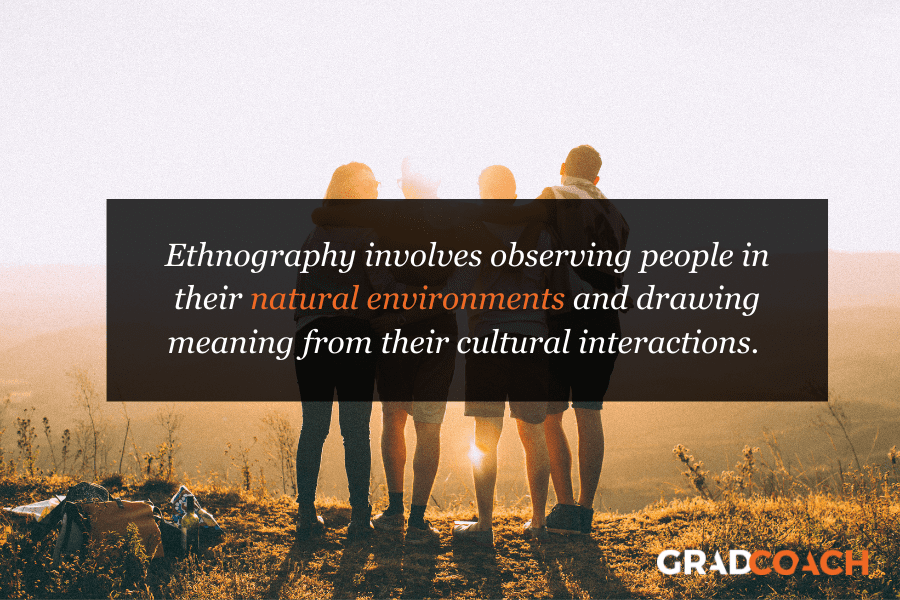
Strategy 6: Archival research
Last but not least is archival research. An archival research strategy draws from materials that already exist, and meaning is then established through a review of this existing data. This method is particularly well-suited to historical research and can make use of materials such as manuscripts and records.
For example, if you were interested in people’s beliefs about so-called supernatural phenomena in the medieval period, you could consult manuscripts and records from the time, and use those as your core data set.
As you can see, there is a wide range of choices in terms of research strategy. The right choice for your project will depend largely on your research aims and objectives, as well as the choices you make in terms of research philosophy and approach.
Onion Layer 4: Choices
The next layer of the research onion is simply called “choices” – they could have been a little more specific, right? In any case, this layer is simply about deciding how many data types (qualitative or quantitative) you’ll use in your research. There are three options – mono , mixed , and multi-method .
Let’s take a look at them.
Choosing to use a mono method means that you’ll only make use of one data type – either qualitative or quantitative. For example, if you were to conduct a study investigating a community’s opinions on a specific pizza restaurant, you could make use of a qualitative approach only, so that you can analyse participants’ views and opinions of the restaurant.
If you were to make use of both quantitative and qualitative data, you’d be taking a mixed-methods approach. Keeping with the previous example, you may also want to assess how many people in a community eat specific types of pizza. For this, you could make use of a survey to collect quantitative data and then analyse the results statistically, producing quantitative results in addition to your qualitative ones.
Lastly, there’s multi-method . With a multi-method approach, you’d make use of a wider range of approaches, with more than just a one quantitative and one qualitative approach. For example, if you conduct a study looking at archives from a specific culture, you could make use of two qualitative methods (such as thematic analysis and content analysis ), and then additionally make use of quantitative methods to analyse numerical data.

Onion Layer 5: Time horizon
What’s that far in the distance? It’s the time horizon. But what exactly is it? Thankfully, this one’s pretty straightforward. The time horizon simply describes how many points in time you plan to collect your data at . Two options exist – the cross-sectional and longitudinal time horizon.
Imagine that you’re wasting time on social media and think, “Ooh! I want to study the language of memes and how this language evolves over time”. For this study, you’d need to collect data over multiple points in time – perhaps over a few weeks, months, or even years. Therefore, you’d make use of a longitudinal time horizon. This option is highly beneficial when studying changes and progressions over time.
If instead, you wanted to study the language used in memes at a certain point in time (for example, in 2020), you’d make use of a cross-sectional time horizon. This is where data is collected at one point in time, so you wouldn’t be gathering data to see how language changes, but rather what language exists at a snapshot point in time. The type of data collected could be qualitative, quantitative or a mix of both, as the focus is on the time of collection, not the data type.

Onion Layer 6: Techniques and Procedures
Finally, we reach the centre of the onion – this is where you get down to the real practicalities of your research to make choices regarding specific techniques and procedures .
Specifically, this is where you’ll:
- Decide on what data you’ll collect and what data collection methods you’ll use (for example, will you use a survey? Or perhaps one-on-one interviews ?)
- Decide how you’ll go about sampling the population (for example, snowball sampling, random sampling, convenience sampling, etc).
- Determine the type of data analysis you’ll use to answer your research questions (such as content analysis or a statistical analysis like correlation).
- Set up the materials you’ll be using for your study (such as writing up questions for a survey or interview)
What’s important to note here is that these techniques and procedures need to align with all the other layers of the research onion – i.e., research philosophy, research approaches, research strategy, choices, and time horizon.
For example, you if you’re adopting a deductive, quantitative research approach, it’s unlikely that you’ll use interviews to collect your data, as you’ll want high-volume, numerical data (which surveys are far better suited to). So, you need to ensure that the decisions at each layer of your onion align with the rest, and most importantly, that they align with your research aims and objectives.

Let’s Recap: Research Onion 101
Saunder’s (2007) research onion details the many interrelated choices you’ll need to make when you’re crafting your research methodology. These include:
- Research philosophy – the set of beliefs your research is based on (positivism, interpretivism, pragmatism)
- Research approaches – the broader method you’ll use (inductive, deductive, qualitative and quantitative)
- Research strategies – how you’ll conduct the research (e.g., experimental, action, case study, etc.)
- Choices – how many methods you’ll use (mono method, mixed-method or multi-method)
- Time horizons – the number of points in time at which you’ll collect your data (cross-sectional or longitudinal)
- Techniques and procedures (data collection methods, data analysis techniques, sampling strategies, etc.)
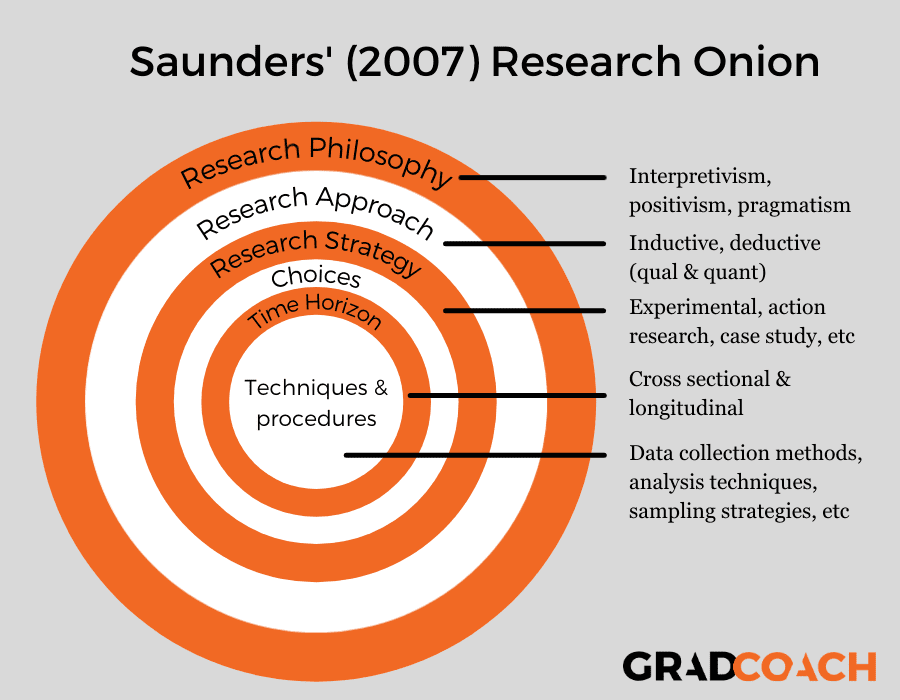
Become A Methodology Wiz ✨

Qualitative Research Basics: The 20,000-Foot View
New to qualitative? Learn about the four key phases of the qualitative research process: data collection, coding, analysis, and writing.

How To Choose The Right Qualitative Analysis Method
Not sure which qualitative analysis method to use? Learn how to choose the right method for your specific research project.

Reflexivity & Triangulation In Qualitative Research
Learn how reflexivity and triangulation help manage subjectivity in qualitative research by enhancing credibility and minimising bias.

Trustworthiness In Qualitative Research
Learn about the four pillars of trustworthiness in qualitative research: credibility, transferability, dependability, and confirmability.

How To Choose A Tutor For Your Dissertation
Hiring the right tutor for your dissertation or thesis can make the difference between passing and failing. Here’s what you need to consider.
📄 FREE TEMPLATES
Research Topic Ideation
Proposal Writing
Literature Review
Methodology & Analysis
Academic Writing
Referencing & Citing
Apps, Tools & Tricks
The Grad Coach Podcast
66 Comments
This is good
Wow this was sooo helpful. I don’t feel so blank about my research anymore. With this information I can conquer my research. Going ‘write’ into it. Get it write not right hahahaha
Very good article . Thanks a million
Do you use each of these as headings for your methodology section
I am doing research with Bolton University so i would like to empower myself.
Really thoughtful presentation and preparation. I learnt too much to teach my students in a very simple and understandable way
Very useful, thank you.
You’re most welcome. Good luck with your research!
thanks alot for your brief and brilliant notes
I am a Student at Malawi Institute of Management, pursuing a Masters’ degree in Business Administration. I find this to be very helpful
Extremely useful, well explained. Thank you so much
I would like to download this file… I can’t find the attachment file. Thanks
Thank you so much for explaining it in the most simple and precise manner!
Very thoughtful and well expained, thanks.
This is good for upgrade my research knowledge
I have enjoying your videos on YouTube, they are very educative and useful. I have learned a lot. Thanks
Thank you this has really helped me with writing my dissertation methodology !
Thanks so much for this piece. Just to be clear, which layer do interviews fit in?
well explained i found it to be very engaging. now i’m going to pass my research methods course. thank you.
Thank you so much this has really helped as I can’t get this insight from uni due to covid
well explained with more clarity!
this is an excellent piece i find it super helpful
Beautiful, thank you!
Am from Malawi @ LAMAU University. I think this is so helpful and the info is applicable and simple to understand.
Beautiful and helpful. Thank you!
This is well done!
A complex but useful approach to research simplified! I would like to learn more from the team.
A very simplified version of a complex topic. I found it really helpful. I would like to know if this publication can be cited for academic research. Thank you
You’re welcome to cite this page, but it would be better to cite the original work of Saunders.
Thirteen odd years since my MSc in HRM & HRD at UoL. I’d like to say thank you for the effort to produce such an insightful discussion of a rather complex topic.
I am a PhD in Media Studies student. I found this enormously helpful when stringing together the methodology chapter, especially the research philosophy section.
Hello there. Thank you for summarising the work on the onion. A more recent version of the onion (Saunders et al., 2019) refers to ‘methodological choices’ rather than choices. This can be downloaded, along with the chapter dealing with research philosophies at: https://www.researchgate.net/publication/330760964_Research_Methods_for_Business_Students_Chapter_4_Understanding_research_philosophy_and_approaches_to_theory_development or https://www.academia.edu/42304065/Research_Methods_for_Business_Students_Chapter_4_Understanding_research_philosophy_and_approaches_to_theory_development_8th_edition
Thank you Mark Saunders. Your work is very insightful
Thank you for the update and additional reading Mark, very helpful indeed.
THROUGHLY AND SIMPLY BRIEFED TO MAKE SENSE AND A CLEAR INSIGHT. THANK YOU, VERY MUCH.
Thank you for the sharing the recent version of the Onion!
I want to keep it in my reference of my assignment. May I??
Great summary, thank you taking the time to put this together. I’m sure it’s been a big help to lots of people. It definitely was to me.
I love the analysis… some people do not recognize qualitative or quantitative as an approach but rather have inductive, abductive, and deductive.
This has been helpful in the understanding of research . Thank you for this valuable information.
Great summary. Well explained. Thank you, guys.
This makes my fears on methodology go away. I confidently look forward to working on my methodology now. Thank you so much I ma doing a PhD with UNIMA, School of Education
simple and clear
Simple guide to crafting a research methodology. Quite impactful. Thank you
Thank you for this, this makes things very clear. Now I’m off to conquer my research proposal. Thanks again.
Thank you for this very informative and valuable information. What would the best approach be to take if you are using secondary data to form a qualitative study and relying on industry reports and peer journals to distinguish what factors influence the use of say cryptocurrency ?
Thanks for providing the whole idea/knowledge in the simplest way with essential factors which made my entire research process more efficient as well as valuable.
what is about research design such as descriptive, causal-comparative, correlation, developmental where these fall in the research onion?
This is very helpful. Thank you for this wonderful piece. However, it would be nicer to have References to the knowledge provided here. My suggestion
This material is very important for researchers, particularly for PhD scholars to conduct further study.
This was insightful. Thank you for the knowledge.
Thank you for the wonderful knowledge !Easy to understand and grasp.
thanks very much very simple. will need a coach
Hi this is a great article giving much help to my research. I just wanted to mention here that the example where you mentioned that ” schizophrenic symptoms like hallucinations are viewed positively, as they are thought to indicate the person is a spirit medium” is completely false as those are different cases and a bit out of context here. We are medically and psychologically well versed and obviously understand the difference between the two. As much as I am grateful to this article I would like to suggest you to give proper examples.
Thank you very much, sincerely I appreciate your efforts, it is insightful information. Once again I’m grateful .
In short, a complete insight of and for writing research methodology.
This information was very helpful, I was having difficulties in writing my methodology now I can say I have the full knowledge to write a more informative research methodology.
Thank you so much for this amazing explanation. As a person who hasn’t ever done a research project, this video helped me to clear my doubts and approach my research in a clear and concise manner. Great work
very well explained , after going through this there is no need any material to study . a very concise and to the point.
I have one small query. If I choose mixed -methods (quantitative and qualitative techniques), Then, my research Philosophy will also change to both Positivists and Interpretivist. Isn’t?
well explained and thank you
Thanks for this presentation. Quite simple and easy to understand, and to teach others.
Hello! Having made a decision to use a particular research philosophy, how then do we go about justifying that choice with references? Thank you.
Thank you, Mark Saunders, for sharing the latest version of the research onion. I would like to know what ‘access’ in the procedure and techniques means. Thank you.
This very interesting and helpful. Thank you so much.
Submit a Comment Cancel reply
Your email address will not be published. Required fields are marked *
Save my name, email, and website in this browser for the next time I comment.
Submit Comment
- Print Friendly
- Essay Writing
- Dissertation Writing
- Assignment Writing
- Report Writing
- Literature Review
- Proposal Writing
- Poster and Presentation Writing Service
- PhD Writing Service
- Coursework Writing
- Tutoring Service
- Exam Notes Writing Service
Editing and Proofreading Service
Technical and Statistical Services
- Appeals and Re-Submissions
Personal Statement Writing Service
- Sample Dissertations
- Sample Essays
- Free Products
Understanding the Research Onion
The research onion model.
The research onion model was presented by Saunders, Lewis and Thornhill in their book titled Research Methods for Business Students . This model aims to explain the different stages of writing a dissertation to help students create a better organised methodology. The below Research Onion model symbolically illustrates the ways in which different elements involved in the research could be examined to develop the final research design.
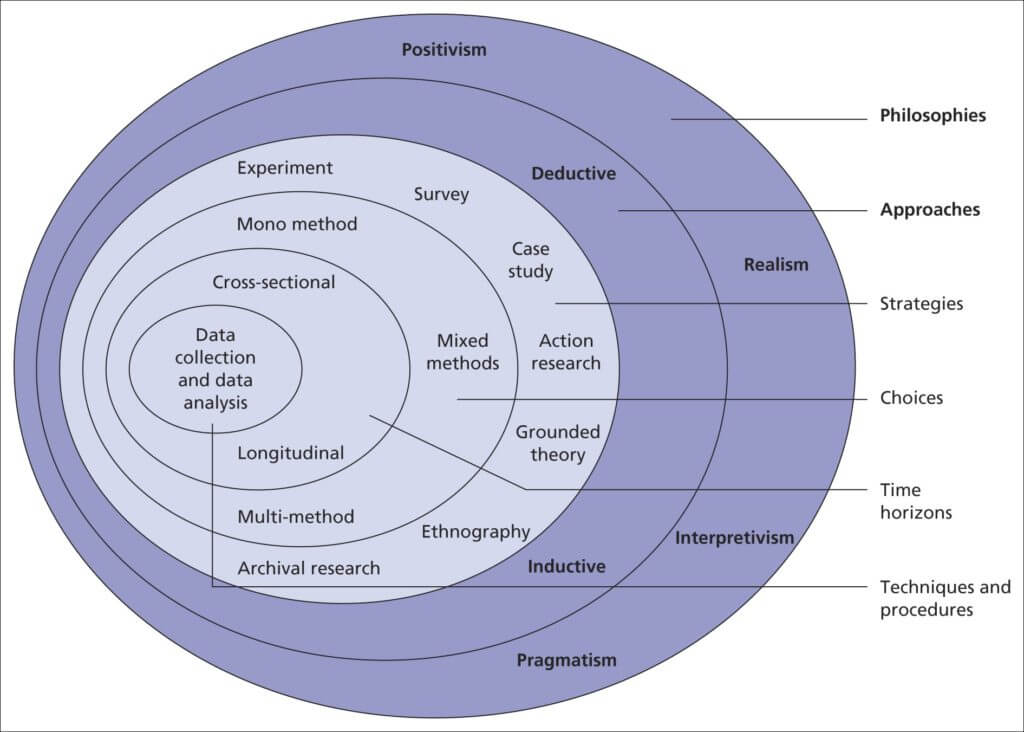
Layers of the Research Onion
The research onion consists of six main layers, which can be explained as:
It refers to the set of principles concerning the worldview or stance from which the research is conducted. It is usually studied in terms of ontology and epistemology. Here, ontology refers to the authenticity of the information and how one understands its existence, whereas epistemology refers to the valid information required for the research and how one can obtain it. Philosophical positions used in academic studies are often divided into positivism and interpretivism, where positivism assumes that knowledge is independent of the subject being studied, and interpretivism claims that individual observers have their own perception and understanding of reality. Hence positivist studies are often more scientific and result in testing phenomena, whereas interpretivist studies are often qualitative in nature.
Once the student has chosen the appropriate methodology, the research onion suggests that an appropriate research must be picked. The deductive approach starts with a specific hypothesis development based on the literature review that has been observed by the researcher, and gradually tries to test this hypothesis and check if it holds in particular contexts. In contrast, the inductive approach starts with observations that the researcher uses to create a new theory.
After this, the student is expected to devise the strategy of the study. The research onion suggests that strategies can include action research, experimental research, interviews, surveys, case study research or a systematic literature review. The strategy is chosen based on the data required for the research and the purpose of the study.
Choices of Methods
The research onion suggests mono-method, mixed method and multi-method as possible choices for conducting research. The mono-method comprises only one method for the study. The mixed method is based on the use of two or more methods of research and commonly refers to the use of qualitative and quantitative methodology. Finally, the multi-method uses a wider selection of methods.
Time Horizons
It refers to the time frame of the research. Generally, observations can be of two types based on time horizons, namely cross-sectional and longitudinal. The cross-sectional data is used when all observations are for a single point of time such as in most surveys. Longitudinal data, in contrast, implies the observations for a particular variable that are available for several years, quarters, months or days.
Data Collection and Analysis
This is the final layer of the research onion and consists of the techniques and procedures used. It is used to clearly explain the ways and purposes of the research conducted. At this stage, the student is expected to choose between the primary and secondary data and between qualitative and quantitative data collected from different sources. Data is considered the central piece in the research onion framework.
If you are struggling with choosing the right methods for your dissertation, feel free to use our methodology generator tool that uses elements of the research onion.
Monday - Friday: 9am - 6pm
Saturday: 10am - 6pm
Got Questions?
Email: [email protected]
*We do NOT use AI (ChatGPT or similar), all orders are custom written by real people.
Our Services
Essay Writing Service
Assignment Writing Service
Coursework Writing Service
Report Writing Service
Reflective Report Writing Service
Literature Review Writing Service
Dissertation Proposal Writing Service
Dissertation Writing Service
MBA Writing Service


- Research Essentials
The Research Onion: peeling back the layers
by Glenn Stevens

Embarking on a research journey involves navigating through various layers of complexity, each contributing to the richness and depth of the study. The metaphorical “research onion,” proposed by Saunders et al., provides a systematic framework for comprehending the multifaceted nature of research design. In this post, we’ll peel back the layers of the research onion, exploring its components and elucidating how it guides researchers through the intricacies of the research process.

The Concept of the Research Onion:
The research onion is a metaphorical model that visualizes the layers of a research study, emphasizing the progression from broad philosophical assumptions to specific research methods and techniques. Developed by Mark Saunders, Philip Lewis, and Adrian Thornhill, the research onion encourages researchers to consider each layer systematically, ensuring a cohesive and well-structured study.
Layers of the Research Onion:
- The outermost layer of the research onion encompasses philosophical assumptions, representing the researcher’s worldview and guiding principles. This layer includes ontological (nature of reality), epistemological (nature of knowledge), and methodological (nature of inquiry) considerations.
- Beneath the philosophical assumptions lies the paradigm layer, where researchers choose a specific research approach. Common paradigms include positivism, interpretivism, and pragmatism. The chosen approach shapes the overall research design and influences the methods employed.
- The strategies layer involves selecting the overarching research strategy that aligns with the chosen paradigm. Strategies may include experiments, surveys, case studies, or action research. This layer guides the overall structure of the study and the type of data collected.
- Moving further inward, the time horizon layer addresses the temporal scope of the research. Researchers decide whether their study will be cross-sectional or longitudinal, influencing the duration and timeframe of data collection.
- The data layer involves selecting specific methods for gathering data. Common methods include surveys, interviews, observations, and document analysis. This layer is crucial for collecting relevant and reliable data aligned with the research questions.
- Sampling decisions are made in the sample layer, determining the characteristics and size of the study’s sample. Researchers choose between probability and non-probability sampling methods, aiming for a representative and applicable sample.
- The analysis layer involves selecting appropriate techniques for analyzing the collected data. Quantitative studies may use statistical methods, while qualitative studies may employ thematic analysis or grounded theory. This layer ensures the meaningful interpretation of data.
- At the core of the research onion lies ethical considerations. Researchers must address ethical issues related to participant consent, confidentiality, and the overall integrity of the study. Ethical considerations are integral to conducting responsible and respectful research.

Benefits of the Research Onion Model:
- The research onion provides a systematic approach to decision-making at each layer, ensuring that choices align with the overarching goals of the study.
- By considering each layer of the onion, researchers can create a coherent and well-designed study that aligns with their philosophical assumptions and paradigmatic choices.
- The model allows for flexibility, enabling researchers to adapt their approach based on the nature of the research questions, available resources, and the context of the study.
- The research onion serves as a communication tool, allowing researchers to clearly articulate their philosophical stance, research approach, and methodological choices to peers and stakeholders.
The research onion stands as a guiding metaphor, leading researchers through the layers of complexity inherent in the research process. By systematically considering each layer, researchers can design studies that are methodologically robust, ethically sound, and aligned with their overarching research goals. As you embark on your research journey, let the layers of the research onion guide you, ensuring a thoughtful and comprehensive approach to the exploration of knowledge and discovery.
Recommended reading

Saunders, M., Thornhill, A., & Lewis, P. (2023). Research Methods for Business Students. Pearson. (Click to view on Amazon #Ad)
Research Methods for Business Students has been fully revised for this ninth edition and continues to be the market-leading textbook in its field, guiding hundreds of thousands of student researchers to success in their research methods modules, research proposals, projects and dissertations. From the creators of ‘the Research Onion”.

Posted by Glenn Stevens
Glenn is an academic writing and research specialist with 15 years experience as a writing coach and PhD supervisor. Also a qualified English teacher, he previously had an extensive career in publishing. He is currently the editor of this website. Glenn lives in the UK. Contact Glenn Useful article? Why not buy Glenn a coffee!
Share this:
Tags: academic research research onion
You may also like...

Using PRISMA for Systematic Reviews: A Step-by-Step Guide
by Glenn Stevens · Published

Sampling Methods: Probability vs. Non-Probability Sampling

Randomised Control Trials (RCTs) in Research
- Next story Blended Learning: Bridging the Educational Divide
- Previous story Cost of proofreading: How much to proofread my academic writing?

- Academic Writing Service
- Privacy Policy
Useful articles? Why not buy the author a coffee using the link below.
academic research academic writing AI Artificial intelligence case study ChatGPT data dissertation doctorate Editing ethics generalizability interviews Introduction leadership Literature review management masters methodology methods mixed methods motivation Paraphrasing phd plagiarism proofreading proof reading psychology qualitative qualitative research quantitative quantitative research research research design researcher sampling student students supervisor survey technology theory undergraduate university Writing

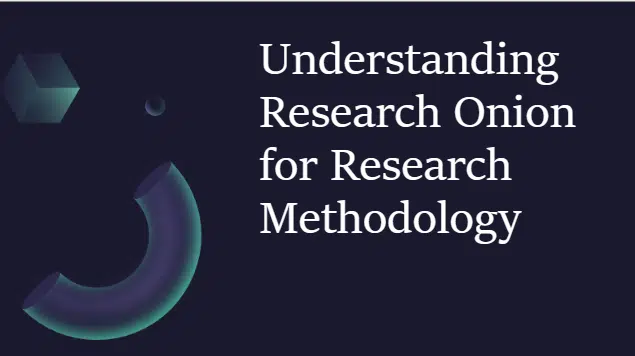
Understanding Research Onion for Research Methodology
Research onion is a framework for developing different types of research methodology, depending upon the objective of the study. Research onion was developed by Saunders et al (2007) in their book “Research Method for Business Students”. The model consists of multiple layers that are arranged in a way similar to the layers of an onion.

Research Onion Methodology Examples
The outermost layer represents four types of research philosophies that include positivism , interpretivism , pragmatism , and realism (Saunders, 2007) . The first decision is to choose a research philosophy to develop foundation of the overall research methodology.
Quantitative Research
The purpose of quantitative research is to understand patterns, causes, and relationship between different variables. Quantitative research is actually positivist research that aims to validate hypothesis derived from existing theories. Such studies are based on deductive reasoning approach. These studies intend to test existing theories by utilizing a specific dataset collected from samples. Explanatory research is a type of investigation used in quantitative research to explain statistical relationship between variables within the scope of the study (Seakran, 2003). Monomethod quantitative research uses only one method to gather data from sources and performing analysis of data.
Also Read: Time Horizon in Research onion
Qualitative Research
Qualitative research aims to understand different process, subject, or phenomenon. Interpretivist studies are qualitative research aiming to develop a deeper understanding of the underlying phenomenon. E thnographic research, phenomenological research, case study, grounded theory , and action theory are different types of qualitative research. The purpose of inductive reasoning is to develop theories using organized observation and analysis of observations. In these studies, researchers do not use hypothesis testing to test existing theories but rather focus on developing new theories.
Mixed Research
Mixed research is a combination of qualitative and quantitative research. Pragmatism enables researchers to develop research methodology that can address the research objectives and problem statement effectively. Pragmatism is flexible and not based on limitations of qualitative and quantitative research. Mixed research integrates advantages of qualitative and quantitative research within a single study to overcome their respective limitations. Such research is sequential that understands a phenomenon and tests the hypothesis derived from findings of the study.Researchers use the sequential approach of employing inductive and deductive reasoning in such studies (Creswell, 2007).
Creswell. (2007). Research Design- Qualitative and mixed methods approaches. London: Sage Publishers. Saunders, M. L. (2007). Research methods for business students (5th ed.). Essex: Pearson Education Limited. Seakran, U. (2003). Research Methods for Business. United States: John Wiley and Sons. Retrieved from https://iaear.weebly.com/uploads/2/6/2/5/26257106/research_methods_entiree_book_umasekaram-pdf-130527124352-phpapp02.pdf
Recent Posts
What is nominal scale in research, strategic planning in small and medium-sized enterprises, what are types of strategy in strategic management.
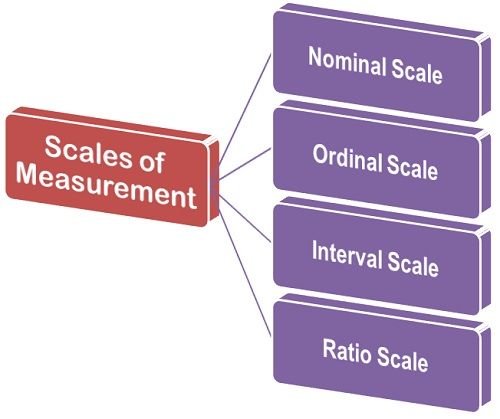
Importance of Measurement Scales in Research: Measuring What Matters
Discovering the magic of digital marketing: your guide to online success.

Strategic Management Frameworks

Types of Strategies in Strategic Management
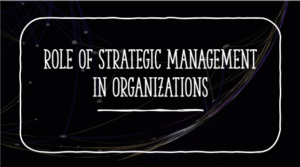
Role of Strategic Management in Organizations
Saunders Research Onion: A Guide To Building Research Methodology Chapter For Master’s And PhD Students
by bookmyphdeditor.com | Jan 17, 2023 | PhD | 0 comments

As a Master’s or PhD student, one of the most critical components of your research project is the methodology chapter. This section of your thesis outlines the framework you’ll use to answer your research question or hypothesis. One useful tool to help you structure your methodology chapter is the Saunders Research Onion.
Developed by Professor Mark Saunders, the Saunders Research Onion is a unique and versatile research framework that can help guide you through the process of conducting and reporting research. In this article, we’ll take a closer look at the Saunders Research Onion and show you how to use it to structure your methodology chapter.
What is the Saunders Research Onion?
The Saunders Research Onion is a multi-layered model that depicts the various stages involved in conducting research. The onion model features six layers, with each layer representing a different aspect of the research process. The layers of the onion model include:
- Research Philosophies
- Research Approaches
- Research Strategies
- Research Choices
- Time Horizons
- Techniques and Procedures (Data Collection and Data Analysis Methods)
Each layer builds on the previous one and helps to clarify and refine the research process. By using the Saunders Research Onion, you can create a structured and logical approach to conducting and reporting your research.
The first layer of the Saunders Research Onion is the Research Philosophy layer, which is an essential aspect of research methodology. It is concerned with the underlying assumptions and beliefs that guide the research process. This layer comprises three sub-layers: Epistemology, Ontology, and Axiology.
Epistemology is concerned with the nature of knowledge and how it can be acquired. The three dominant paradigms within epistemology are Positivism, Realism, and Interpretivism. Positivism holds that knowledge can only be gained through empirical observation and scientific methods. Realism posits that there is an objective reality that exists independently of the observer, and that knowledge can be acquired through direct observation of this reality. Interpretivism, on the other hand, suggests that reality is subjective and that knowledge is acquired through interpretation and understanding of the social world.
Ontology , the second sub-layer of research philosophy, is concerned with the nature of reality and the assumptions that underpin it. There are three dominant paradigms within ontology, namely Objectivism, Constructivism, and Pragmatism. Objectivism posits that there is a single objective reality that exists independently of the observer. Constructivism suggests that reality is socially constructed and that it is shaped by the individual’s experiences and interactions with the world. Pragmatism posits that reality is constructed through the individual’s experiences and interactions with the world, and that the truth is relative to the context in which it is defined.
The third sub-layer of Research Philosophy is Axiology , which is concerned with the values and ethical considerations that guide the research process. It includes considerations such as ethical principles, cultural values, and political beliefs. Axiology is essential to ensure that the research is conducted in a manner that is ethical and reflects the values of the research community.
It is crucial for researchers to understand the different paradigms within epistemology and ontology, as well as the ethical considerations within axiology. This understanding helps researchers to select an appropriate research methodology that is aligned with their research question and objectives. Moreover, this understanding enables researchers to critically evaluate existing literature and to select appropriate research methods for their studies.
The research approach you choose will depend on your research question and the nature of your research problem. Saunders Research Onion identifies two main research approaches – deductive and inductive.
Deductive approach : In the deductive approach, researchers start with a theory and then test it through empirical data collection. The researcher will develop a hypothesis and then collect data to confirm or refute the hypothesis. This approach is commonly used in quantitative research.
Inductive approach : The inductive approach, on the other hand, is where the researcher starts with a set of observations or data and then tries to develop a theory or explanation based on the patterns that emerge. This approach is common in qualitative research.
Research strategies refer to the specific techniques or methods used to collect and analyze data. Saunders Research Onion identifies several research strategies:
Experiment: In an experiment, the researcher manipulates one or more independent variables to observe their effect on a dependent variable. This research strategy is typically used in laboratory settings.
Survey: In a survey, the researcher collects data from a sample of participants using questionnaires, interviews, or online surveys. This strategy is commonly used in social sciences and business research.
Case Study: In a case study, the researcher analyzes a specific case or phenomenon in depth, usually using multiple sources of data, such as interviews, documents, and observations. This strategy is commonly used in social sciences and business research.
Action research: In action research, the researcher collaborates with a group of participants to identify and solve a problem or improve a situation. This strategy is commonly used in organizational and educational research.
Grounded Theory: In grounded theory, the researcher develops a theory or explanation based on the patterns and themes that emerge from the data. This strategy is commonly used in qualitative research.
Ethnography: In ethnography, the researcher studies a particular culture or community in depth by collecting data through interviews, observations, and other sources. This strategy is commonly used in social sciences and anthropology.
Archival Research: In archival research, the researcher collects data from existing sources, such as historical documents, government records, or organizational archives. This strategy is commonly used in historical and legal research.
Research choices refer to the decision of the researcher to use a single method, multiple methods, or mixed methods in their research. Saunders Research Onion identifies three research choices:
Mono method: In mono-method research, the researcher uses a single research method, either qualitative or quantitative, to collect and analyze data.
Multi-method: In multi-method research, the researcher uses multiple research methods, either qualitative or quantitative, to collect and analyze data.
Mixed-method: In mixed-method research, the researcher uses both qualitative and quantitative methods to collect and analyze data.
Time horizons refer to the duration of time over which data is collected. Saunders Research Onion identifies two types of time horizons:
Cross-sectional: In cross-sectional research, the researcher collects data at a single point in time.
Longitudinal: In longitudinal research, the researcher collects data over an extended period of time, often through repeated measurements or observations.
- Techniques and Procedures – Data Collection and Data Analysis
Data collection and data analysis are critical components of research methodology, and they are also a part of the sixth layer of the Saunders Research Onion model. Techniques and procedures used for data collection and analysis will depend on the research approach, strategy, and time horizon selected by the researcher.
There are various data collection methods, including surveys, interviews, focus groups, observation, and experiments. Each method has its strengths and weaknesses, and the researcher must choose the most appropriate method based on the research objectives and the nature of the research question. It is also essential to consider ethical issues related to data collection, such as obtaining informed consent, maintaining confidentiality, and protecting participants from harm.
Data analysis techniques are also crucial for research methodology, and they can be broadly divided into two categories: qualitative and quantitative. Qualitative data analysis involves analyzing data in a non-numerical form, such as text, images, or videos. Common techniques for qualitative data analysis include content analysis, thematic analysis, and discourse analysis.
Quantitative data analysis, on the other hand, involves analyzing numerical data using statistical techniques. Common techniques for quantitative data analysis include descriptive statistics, inferential statistics, and regression analysis. It is important to choose the appropriate data analysis technique based on the type of data collected and the research question.
The Saunders Research Onion model is a valuable tool for structuring the research methodology chapter of a PhD thesis or Master-level dissertation. The model provides a step-by-step approach to research methodology, starting with the research philosophy and ending with the techniques and procedures for data collection and analysis. By using the model, researchers can ensure that their research methodology chapter is comprehensive, well-structured, and logically organized.
It is important to note that while the Saunders Research Onion model provides a useful framework for research methodology, it is not a one-size-fits-all approach. Researchers must carefully consider their research objectives, research question, and other contextual factors when selecting the appropriate research philosophy, approach, strategy, time horizon, and data collection and analysis techniques.
A t Book My PhD Editor , we understand the importance of a well-written and well-structured research methodology chapter. Our team of experienced editors and proofreaders can help you to ensure that your research methodology chapter is clear, concise, and error-free. We also offer data analysis services to help you analyze your research data using the appropriate techniques. Contact us today at [email protected] to learn more about our services and how we can help you with your research methodology chapter.
Bonus Tip for Scholars:
Google Scholar – Google Scholar is a search engine that provides access to academic and scholarly literature, including articles, books, conference papers, and other documents. It is designed to help researchers, students, and academics find relevant scholarly content across a wide range of disciplines. Google Scholar indexes material from a variety of sources, including academic publishers, institutional repositories, and preprint servers, and provides links to full-text versions of many of the documents it lists. Users can search Google Scholar by keyword, author, publication, and other parameters, and can also set up alerts to receive notifications of new publications or citations to their own work.
The research onion.
The Research Onion model , developed by Saunders et al., is a framework that outlines the stages and layers involved in the development of a research methodology. Here’s a detailed table with sections, subsections, and sub-subsections of the Research Onion, along with expanded explanatory notes:
This table outlines the Research Onion model , detailing the stages and layers of research methodology, from philosophy and approach to strategies, choices, time horizons, techniques, ethical considerations, and validity/reliability concerns.
The research onion is a valuable tool for researchers, particularly those formulating a research methodology for a dissertation, thesis, or any other formal research project. Developed by Saunders et al. in 2007, it offers a systematic approach to designing a robust methodology by guiding you through a series of decisions.
Here’s an in-depth breakdown of the research onion’s layers, moving from the outermost layer inwards:
1. Research Philosophy : This layer forms the foundation, representing the underlying beliefs about the nature of knowledge and reality that inform your research . Here, you grapple with fundamental questions like:
- What is the nature of reality? (Positivism: single, objective reality. Interpretivism: multiple, subjective realities)
- How can we acquire knowledge ? (Positivism: through observation and testing. Interpretivism: through interpretation and understanding)
2. Research Approach: Based on your chosen philosophy , you’ll adopt a broader research approach. There are three main options:
- Deductive Approach: This method starts with existing theories and aims to test or refine them through hypothesis testing and experiments. It aligns well with a positivist philosophy .
- Inductive Approach: This approach seeks to develop new theories or understandings through observation and data collection. It goes hand-in-hand with an interpretivist philosophy .
- Abductive Approach: This approach combines elements of deduction and induction. It starts with observations, then uses existing theories to develop new explanations and then tests those explanations.
3. Research Strategies: Here, you delve deeper into how you’ll actually conduct your research . This layer encompasses various strategies like:
- Experiments: Manipulating variables to observe cause-and-effect relationships (often used in deductive approaches)
- Surveys: Collecting data from a large sample of participants through questionnaires (can be used in both deductive and inductive approaches)
- Case Studies: In-depth investigations of a single person, group, or event (often used in inductive approaches)
- Action Research : Conducting research while implementing changes and reflecting on the outcomes (often used in a pragmatic philosophy )
4. Choices/Techniques and Procedures: Within your chosen strategy , you’ll need to specify the specific techniques and procedures for data collection and analysis. This layer might involve decisions like:
- Sample Selection: How will you choose participants for your study ?
- Data Collection Methods: Interviews, surveys, observations, etc.
- Data Analysis Techniques: Statistical analysis, thematic analysis, etc.
5. Time Horizon: This layer considers the timeframe of your research . Will it be:
- Cross-sectional: Data collected at a single point in time.
- Longitudinal: Data collected repeatedly over time to examine changes.
Benefits of the Research Onion:
- Systematic Approach: It guides you through a logical sequence of decisions, ensuring a well-considered methodology.
- Holistic View: It encourages you to consider all the interconnected elements of your research design .
- Improved Research Quality: By carefully considering each layer, you lay the groundwork for a strong and credible research project.
In Conclusion:
The research onion is a powerful tool for researchers of all disciplines. By working through its layers, you can develop a robust and well-structured research methodology that effectively addresses your research questions.
Also, from another source:
“The Research Onion” is a conceptual framework proposed by Saunders et al. (2012) in their book “Research Methods for Business Students.” It provides a systematic approach to understanding the layers involved in conducting research , with each layer representing a different aspect or stage of the research process. The metaphor of an onion is used to depict the layers of complexity involved in research , where each layer needs to be peeled back to reveal deeper insights. Elaborating extensively on the research onion involves delving into its various layers and their significance in the research process:
- Philosophy : At the core of the research onion lies the philosophical stance or worldview adopted by the researcher. This includes ontological (nature of reality), epistemological (nature of knowledge ), and methodological (methods of inquiry) considerations. Researchers may align with positivism, interpretivism, or critical realism, depending on their beliefs about the nature of reality and how knowledge is constructed.
- Approach : The second layer involves choosing a research approach that best fits the philosophical stance. This could be deductive (testing hypotheses derived from existing theory) or inductive (generating theory from empirical observations). The approach also encompasses the overall strategy for conducting research , such as experiments, surveys, case studies, or ethnography.
- Strategy : Within the approach layer, researchers must decide on a specific research strategy that outlines the overall plan for data collection and analysis. Common strategies include experiments, surveys, case studies, action research , and grounded theory. Each strategy has its own strengths, weaknesses, and suitability for different research contexts.
- Choices : This layer involves making decisions regarding the research design , data collection methods, and sampling techniques. Researchers must determine the most appropriate design (e.g., cross-sectional, longitudinal) and select suitable data collection methods (e.g., interviews, questionnaires, observations). Sampling decisions involve selecting the participants or cases that will be included in the study , considering factors such as representativeness, accessibility, and relevance to the research objectives.
- Time Horizons : Time horizons refer to the timeframe over which data is collected and analyzed. Research can be cross-sectional ( data collected at a single point in time), longitudinal ( data collected over an extended period), or a combination of both. The choice of time horizons depends on the research objectives, the nature of the phenomenon under study , and practical considerations such as resource constraints.
- Techniques : The outermost layer of the research onion involves the selection of specific data analysis techniques. This includes qualitative techniques such as thematic analysis, content analysis, and grounded theory, as well as quantitative techniques such as descriptive statistics, inferential statistics, and regression analysis. The choice of techniques depends on the nature of the data collected, the research questions, and the overall research design .
Each layer of the research onion is interconnected, with decisions made at one layer influencing choices at subsequent layers. By systematically peeling back the layers of the onion, researchers can design and conduct rigorous and methodologically sound research studies that contribute to knowledge in their respective fields. The research onion serves as a valuable tool for guiding researchers through the complexities of the research process and ensuring that their studies are theoretically grounded, methodologically robust, and capable of generating meaningful insights.
The research onion is a conceptual framework that provides a systematic and structured approach to conducting research . It was developed by Saunders et al. (2012) and is commonly used in social science research . The research onion consists of multiple layers, each representing a different aspect of the research process. This model helps researchers understand and plan the various stages involved in conducting a study . Let’s explore the layers of the research onion in exemplary detail:
- Research Philosophy : The outermost layer of the research onion is the research philosophy . It represents the researcher’s worldview and the overall approach to knowledge and understanding. There are three main research philosophies:a. Positivism: This philosophy assumes that reality is objective and can be measured and observed. Positivist research aims to discover universal laws and generalizations through a systematic and scientific approach.b. Interpretivism: Interpretivism emphasizes the subjective nature of reality and focuses on understanding and interpreting human experiences and meanings. Researchers adopting this philosophy use qualitative methods to explore the complexity and contextuality of social phenomena.c. Pragmatism: Pragmatism combines elements of both positivism and interpretivism. It acknowledges the importance of both objectivity and subjectivity and employs a mixed-methods approach to answer research questions.
- Research Approach: The second layer of the research onion is the research approach. It determines the overall strategy for collecting and analyzing data . Two main research approaches are commonly used:a. Deductive Approach: In the deductive approach, researchers start with a theory or hypothesis and test it through data collection and analysis. This approach involves the formulation of specific research questions and the use of quantitative methods.b. Inductive Approach: The inductive approach involves collecting data first and then developing theories or explanations based on the analysis of the data . This approach is commonly associated with qualitative research , where researchers aim to generate new insights and theories.
- Research Strategy : The research strategy layer of the onion involves decisions about the overall design and structure of the study . Different research strategies include:a. Experiment: The experimental strategy involves manipulating variables and measuring their effects on the dependent variable(s). It allows researchers to establish causality and control over the research environment.b. Survey: Surveys involve collecting data from a large sample using questionnaires or structured interviews. This strategy aims to gather information about attitudes, opinions, or behaviors from a broader population.c. Case Study : The case study strategy focuses on a detailed examination of a particular individual, group, or organization. It provides an in-depth understanding of a specific context and allows for rich qualitative data collection.d. Ethnography: Ethnography is an observational research strategy that involves immersing the researcher in the social setting being studied. Researchers aim to understand the culture, behaviors, and interactions within a specific group or community.
- Time Horizon: The time horizon layer of the research onion refers to the researcher’s decisions about the duration and scope of the study . Two main time horizons are considered:a. Cross-sectional: Cross-sectional studies collect data at a specific point in time. They provide a snapshot of a particular phenomenon at a given moment.b. Longitudinal: Longitudinal studies involve collecting data over an extended period. They allow researchers to observe changes, trends, and developments over time.
- Data Collection Methods: The data collection methods layer includes decisions about how to collect data . There are various data collection methods, including:a. Interviews: Interviews involve direct interaction between the researcher and participants to gather information and insights. They can be structured, semi-structured, or unstructured.b. Questionnaires: Questionnaires are structured sets of questions administered to participants. They can be self-administered (paper-based or online) or conducted through interviews.c. Observations: Observational methods involve the systematic recording and interpretation of behaviors, interactions, or phenomena in their natural settings.d. Document Analysis: Document analysis involves the examination and interpretation of existing documents, such as official records, reports, or historical data .
- Data Analysis: The data analysis layer focuses on how collected data will be analyzed to answer research questions. Different approaches to data analysis include:a. Quantitative Analysis: Quantitative analysis involves the use of statistical techniques to analyze numerical data collected through surveys or experiments. It aims to identify patterns, relationships, and statistical significance.b. Qualitative Analysis: Qualitative analysis involves the interpretation and thematic analysis of textual or visual data collected through interviews, observations, or documents. It aims to uncover meanings, themes, and patterns in the data .c. Mixed-Methods Analysis: Mixed-methods analysis combines quantitative and qualitative techniques to analyze data from different sources. It allows researchers to triangulate findings and gain a comprehensive understanding of the research problem.
Each layer of the research onion builds upon the previous one, providing a systematic and structured framework for conducting research . Researchers can make informed decisions at each layer based on the nature of their research questions, the context of their study ,and the resources available to them. The research onion helps researchers navigate the complexities of the research process and ensures that all relevant aspects are considered and addressed. By following the layers of the research onion, researchers can conduct rigorous and methodologically sound studies that contribute to knowledge and understanding in their respective fields.
In conclusion, the research onion provides a comprehensive framework for conducting research . It encompasses various aspects of the research process, including research philosophy , approach, strategy , time horizon, data collection methods, and data analysis. By considering each layer of the onion, researchers can design and execute studies that are robust, reliable, and aligned with the research objectives. The research onion serves as a guide for researchers, helping them make informed decisions at each stage of the research process and ensuring the integrity and quality of their work.
Here is a step-by-step guide to conducting research using the Research Onion model , starting from the outer layer and moving to the inner layers, with expanded explanatory notes for each step.
- 1 Step-by-Step Guide Using the Research Onion Model
- 2 Expanded Explanatory Notes
Step-by-Step Guide Using the Research Onion Model
Expanded explanatory notes.
- Positivism : Objective, measurable reality. Focus on facts and observable phenomena.
- Interpretivism : Subjective interpretation. Understanding meaning in social phenomena.
- Direct Realism : Reality as it is observed.
- Critical Realism : Reality is influenced by social and cultural factors.
- Pragmatism : Practical outcomes, integrating both positivist and interpretivist approaches as needed.
- Deductive : Hypothesis testing, typically quantitative.
- Inductive : Theory development from data , typically qualitative.
- Abductive : Best possible explanation from incomplete observations.
- Experiment : Manipulating variables to determine cause and effect.
- Survey : Collecting data through questionnaires or interviews.
- Case Study : In-depth investigation of a single case or few cases.
- Action Research : Collaborative problem-solving and evaluation.
- Grounded Theory : Developing theories from data .
- Ethnography : Immersive study of cultural or social groups.
- Archival Research : Using existing records and documents.
- Mono-Method : Single research method.
- Mixed-Method : Combining qualitative and quantitative methods.
- Multi-Method : Multiple methods of the same type.
- Cross-Sectional : Single point in time.
- Longitudinal : Extended period, observing changes over time.
- Data Collection Methods : Interviews, questionnaires, observations, document analysis.
- Quantitative : Statistical techniques.
- Qualitative : Thematic or content analysis.
- Mixed Methods : Integration of quantitative and qualitative analysis.
- Informed Consent : Participants are fully aware and agree to participate.
- Confidentiality : Protecting participants’ privacy.
- Transparency : Openness and honesty in research .
- Avoidance of Harm : Ensuring no harm comes to participants.
- Internal Validity : Accuracy of measurements within the study .
- External Validity : Generalizability of findings.
- Reliability : Consistency and dependability of findings.
- Triangulation : Using multiple data sources, methods, or theories to cross-verify findings.
- Implement your planned methods for data collection and analysis while adhering to ethical standards.
- Analyze data and draw conclusions based on your research approach, comparing findings with hypotheses or developing new theories.
- Write a detailed report or dissertation, and share your findings through publications, presentations, or reports.
This guide outlines each step of the research process using the Research Onion model , providing detailed explanations for each layer to help structure and conduct thorough and rigorous research .

Digital Assessment and Evaluation Methodologies

Nudging for Change Online Course

Facilitating Learning Labs for Socio-Technical Innovation Bundling (STIB) for Women’s Resilience and Empowerment

Enhancing Resilience of Indian Agriculture to Climate Shocks – The Way Ahead
Blog 132-research onion: a systematic approach to designing research methodology.

- Google Plus
Developing a good research design is important while undertaking quality social science research, and in this blog Dr Mahesh BT illustrates the different stages in designing a research methodology using the Research Onion framework.
When I joined for my PhD, as many of you, I too was curious about research. Along with the curiosity came seriousness, but only after one of my mentors said: “Your thesis is your brainchild and indeed a reflection of you”. I am here now to share a few of the specifics that I learnt during my PhD journey. I will be discussing how to design and present a robust research methodology. Why do I find this concept very crucial? It is because these answers to research questions are valid and reliable – if they are answered through a systematic method(s). Often we find dissertations with a poorly explained research methodology chapter, which is required to be crystal clear in every step, so I was in search of something that can explain things clearly. During my desk research, I came across various ways and means to design research methodology; one of the most crucial revelations for me was a research vegetable called ‘Research onion’. Let us first see what this research onion is all about.
WHAT IS ‘RESEARCH ONION’?
Saunders et al. (2012) proposed the research onion framework (Figure 1), which explains pictorially the various aspects of the research to be examined and planned in order to come up with a sound research design. In other words, the research onion guides the researcher through all the steps that need to be taken when developing a research methodology.
Saunders et al. (2019), divided the research onion into three levels of decisions: 1. First two outer rings, i.e., Research philosophy and Research approach; 2. Research design which constitutes (a) methodological choices, (b) research strategy and (c) time horizon; and (3) tactics, i.e., the inner core of the research onion, which includes data collection and analysis aspects.
Before we strip the research onion let us do an activity. Take an onion and try to peel it from the inside without using a knife. You tried but could not peel it, the systematic way is to peel it from the outside to inside, and this is what we have to do with the research onion as well.
To develop a sound research methodology scholarly research starts with the research question(s), the objectives followed by the series of decisions on choice of research philosophy, approach to research, then the research design, i.e., methodological choices, research strategy, the time horizon, and the last inner core – data collection and data analysis. All the layers of research onion are interrelated and interdependent. In other words, the choice of philosophy influences the approach, which in turn influences the selection of methodological choice, strategy, time horizon, data collection and analysis.
PEELING OUT THE RESEARCH ONION
1.RESEARCH PHILOSOPHY Knowingly or unknowingly a researcher will be making numerous assumptions while embarking on research (Burrell and Morgan 2016).
These assumptions are of three types:
- Ontological assumptions – Assumptions regarding the reality faced in the research or what makes something a reality, and how a researcher can understand existence.
- Epistemological assumptions – Assumptions associated with human knowledge or what forms valid knowledge, whether it can be known, and how a researcher can get it and transfer it.
- Axiological assumptions -These are assumptions about the level of influence of the researcher’s values on the research process or what is essential and valuable in the research.
Further, these assumptions help a researcher to design the research questions, choose appropriate methods, and influence the interpretation of findings (Crotty 1998). These assumptions altogether form the research philosophy of the study. According to Saunders et al. (2012), the term research philosophy refers to ‘a system of beliefs and assumptions about the development of knowledge’.
The ontological assumption is the assumption made by a researcher regarding the nature of reality. Here reality means the study area or a subject domain, such as agricultural extension. The extension fraternity has various assumptions regarding the subject of extension, we assume it to be a study of human (farmers) behaviour, and others say it is the transfer of technology, and so on and so forth. These ontological assumptions may also be with regard to a specific research area in the subject domain. For instance, we study farmers’ adoption of agro-technology, in most adoption studies the researchers presumed that a lower level of adoption (a reality) of technology is the reason for lower crop production. Therefore, the focus was on studying the level of adoption by farmers and how to increase it. On the other hand, some researchers assume technology adoption as a mental process and see that there is low level of adoption everywhere, and so they try to understand why there is a low level of adoption and what are the factors determining the adoption. From this, it is clear that your assumption about the nature of reality (ontology) decides how you view the subject domain (Agricultural Extension) or the research area, which in turn influences what you want to research (what research questions to ask or what research objectives to study).
The epistemological assumption is an assumption made by a researcher regarding knowledge. What forms valid and reliable knowledge? How do we acquire and communicate it? We know that the subject matter of agricultural extension is derived from different disciplines. Therefore, the nature of knowledge will be diverse; it may constitute numerical data (e.g., number of women FPOs) to textual data (results of in-depth interview or focused group discussion), or even visual data (social map, resource map, sociogram). In extension research, facts, opinions, narratives and stories constitute valid knowledge, provided it follows a systematic process of enquiry. You will come across various research studies in extension where the researcher has used different epistemology in their research, research purely based on case studies, and some dealing only with factual stuff.
The axiological assumption is an assumption made by a researcher regarding the influence of values and beliefs on the research. The researcher tries to be free from values and beliefs intruding into the research or positively considers and acknowledges values and beliefs influencing the research process and the conclusions. Sometimes we need to decide on whether the values and beliefs of the research respondents should be considered or not. Researchers argue, as reported by Saunders et al. (2019), that it is very tough to keep ourselves free from the influence of values and beliefs. For instance, as a researcher you might have come across your advisor saying “parametric test is stronger than non-parametric”, “qualitative data gives in-depth understanding about a phenomenon than quantitative data”. What are these assumptions? They are the aspects of research your advisor values more.
At this juncture, you might have questioned yourself – why should I be making assumptions and know the different research philosophies when I can directly collect data, analyse and report the results? There are several aspects for which these assumptions are essential they are listed below.
- Assumptions are your research tour guide; they tell you how to conduct the research, what should be your role – whether you should maintain objectivity or can subjectivity be expressed. They tell you what methods you can follow.
- The researcher has to defend his/her work at various levels. As a student researcher, we get suggestions from the advisory committee or institutional review board to strictly go for quantitative methods with probability sampling, and try to avoid qualitative methods. This is due to the difference in the assumptions or more specifically, the research philosophy they follow. The most challenging is to convince the journal reviewers and editors, there are chances of your paper getting rejected because your philosophy is different from what they follow. Therefore, to show that your overall approach to research is justifiable, you should state your assumptions (research philosophy) very clearly.
- Another issue we come across is sweeping apologies in our dissertation, for instance, a researcher apologises for not interviewing a large number of respondents in qualitative research; and the other one is failing to get an in-depth understanding due to the quantitative nature of research. No! You need not apologise, all that you need to do is follow the standard methods and procedure that suits your research philosophy. Therefore it is very important to understand the various research philosophies.
According to Saunders et al. (2019), there are five research philosophies: (1) positivism; (2) critical realism; (3) interpretivism; (4) postmodernism; and (5) pragmatism. The detailed explanation of these five research philosophies is presented in Tables 1 to 5.
2. THE RESEARCH APPROACH OR APPROACH TO THEORY DEVELOPMENT
The second ring in the research onion contains the research approach. If we critically think on what a researcher does in research, we can classify them into three aspects – theory testing, theory building, and theory modification. The point I am trying to make here is that the research we undertake involves the use of theory which we may or may not name in our research design. You will find the essence of theory in the conclusions of research findings. The selection of a particular philosophy that was discussed in the first section will determine the approach you choose for the development of the theory or for the reasoning behind your findings. Further, the approach you select will influence the choice of research design and methods (Babbie 2010).
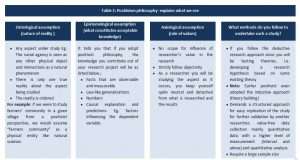
Source: Developed from Saunders et al. (2019) Note: Application of positivist philosophy in social science research is a matter of scholarly debate. However, a researcher can apply some of the assumptions and methods with caution and rationality. Suggested reading: Thomas Houghton, Does positivism really ‘work’ in the social sciences? Link: https://www.e-ir.info/2011/09/26/does-positivism-really-%E2%80%98work%E2%80%99-in-the-social-sciences/
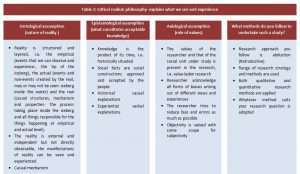
Source: Developed from Saunders et al. (2019) Suggested reading : Fletcher Amber J. Applying critical realism in qualitative research: Methodology meets method. Link: https://www.tandfonline.com/doi/abs/10.1080/13645579.2016.1144401?journalCode=tsrm20
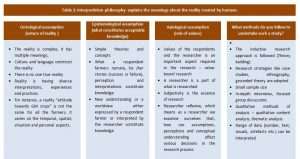
Source: Developed from Saunders et al. (2019) Suggested reading : Chen Y Y, Shek D T L and Bu F F. 2011. Applications of interpretive and constructionist research methods in adolescent research: Philosophy, principles and examples. International Journal of Adolescent Medicine and Health 23(2).doi:10.1515/ijamh.2011.022 https://pubmed.ncbi.nlm.nih.gov/21870675/
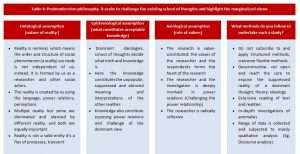
Source: Developed from Saunders et al. (2019) Suggested reading : Rosenau P V. Postmodernism: Methodology. https://doi.org/10.1016/B0-08-043076-7/00692-6 Link : https://www.sciencedirect.com/science/article/pii/B0080430767006926
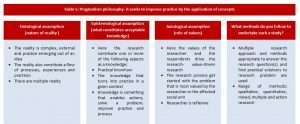
Source: Developed from Saunders et al. (2019) Suggested reading: Crist J D, Parsons M L, Warner-Robbins C, Mullins M V and Espinosa Y M. 2009. Pragmatic action research with 2 vulnerable populations. Family & Community Health 32(4):320–329. doi:10.1097/fch.0b013e3181b9
According to Saunders et al. (2012), there are three research approaches viz., induction, deduction, and abduction. A brief overview of the research approaches is presented in Table 6.
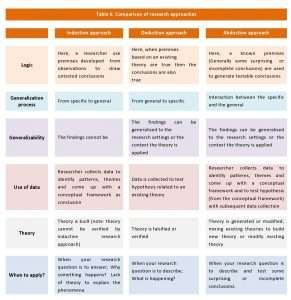
2.1 In this section I have graphically explained all the three research approaches using flowchart with hypothetical examples. 2.1.1 Inductive approach to research
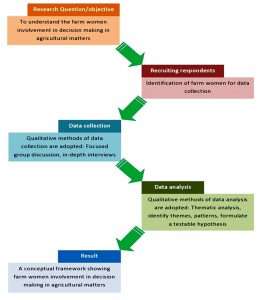
Suggested reading: Ferguson K M, Kim M A and McCoy S. 2011. Enhancing empowerment and leadership among homeless youth in agency and community settings: A grounded theory approach. Child and Adolescent Social Work Journal 28(1):122. https://doi.org/10.1007/s10560-010-0217-6
2.1.2 Deductive approach to research
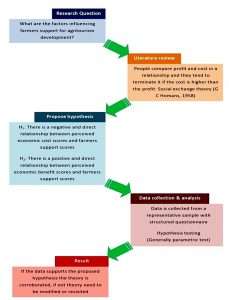
Suggested reading: Chia-Pin Yu, Shu Tian Cole and Chancellor Charles. 2018. Resident support for tourism development in rural midwestern (USA) communities: Perceived tourism impacts and community quality of life perspective. Sustainability, MDPI, Open Access Journal 10(3):1-17.
2.1.3 Abductive approach to research
You may find some surprising or incomplete observations or conclusions regarding any social aspect; you wanted to study it both empirically as well as know the subjective opinions of people for better understanding. In this situation, you follow the abduction approach in which your research will combine the elements of both the inductive and deductive approaches. To put it in simple words, in abduction ‘You build a theory and then go for its empirical testing’.
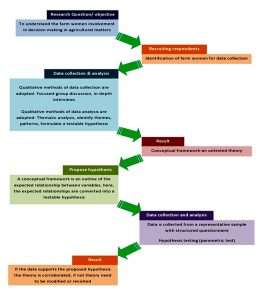
Suggested reading: Bristow A, Robinso S K and Ratle O. 2017. Being an early-career CMS academic in the context of insecurity and ‘Excellence’: The dialectics of resistance and compliance. Organization Studies 38(9):1185–1207.
Research design: It is the overall plan of a research project which involves three distinct but interrelated aspects. They are: methodological choice, research strategy and time horizon. Let us understand them separately. Sanders et al. (2019) classified research designs into three types: (1) quantitative research design; (2) qualitative research design; and (3) mixed methods research design. I have attempted to develop a schematic explanation for qualitative and quantitative research design (Figures 4 and 5, respectively) for better understanding.
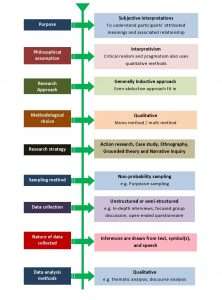
3. METHODOLOGICAL CHOICE
Methodological Choice involves the selection and use of a quantitative, qualitative, or mixed methods research design. In the mono method, a single data collection technique is utilized, followed by corresponding qualitative or quantitative analysis procedures. In the multiple method design, more than one data collection techniques and analysis procedures are employed (Collis and Hussey 2013). Alternatively, a mixed-method approach utilizes both qualitative and quantitative data collection techniques and analysis procedures (Creswell 2013).
According to Saunders et al. (2019), mixed method research can be classified into three ways which are as follows:
- Concurrent mixed methods research: Here a researcher collects both qualitative and quantitative data and analyses them in a single phase study.
- Sequential mixed methods research : Here a researcher collects and analyses data in two phases, which can further be divided into two forms:
- sequential exploratory research design: where a researcher collects and analyses qualitative data in the first phase, followed by quantitative data collection and analysis in the second phase;
- sequential explanatory research design: Here a researcher collects and analyses quantitative data in the first phase followed by qualitative data collection and analysis in the second phase.
- Sequential multi-phase: In this a researcher collects and analyses data in more than two phases, in sequence. For example, qualitative followed by quantitative and then qualitative.
4. THE RESEARCH STRATEGY
The research strategy describes how the researcher aims to carry out the work (Saunders et al . 2007). There are several research strategies, viz., Experimental design, Survey design, Archival research, Case study, Ethnography, Action research, Grounded theory and Narrative inquiry (Saunders et al. 2012). Here we can include other research strategies appropriate to our study.
- Experimental design : Here, a researcher tries to study a cause-effect relationship between two or more variables. He/she decides to systematically manipulate the independent variable to study the corresponding changes in the dependent variable.
- Survey design: Here, a researcher tries to seek answers for ‘what’, ‘who’, ‘where’, ‘how much’ and ‘how many’ types of research questions. Data is collected and analyzed from a sample of individuals.
- Case study: is an empirical inquiry of an individual social unit. Here the researcher tries to seek answers for ‘how’ and ‘why’ questions.
- Action research : A systematic inquiry to address real-life practical problems. Here a researcher tries to find practical solutions for problems through participation and collaboration with members of a social unit.
- Grounded theory: This is a systematic inductive method for conducting qualitative research to develop a theory.
- Ethnography : is a research strategy adopted to explore cultures and societies. Here a researcher collects data through direct interaction and involvement so as to gain firsthand information from research subjects.
- Archival research: A systematic inquiry wherein primary sources held in archives are studied for evidence collection or deep understanding. Here a researcher does not use secondary sources relevant to the research topic.
5. TIME HORIZON
Research can be grouped into two types based on time, i.e., longitudinal or successive independent samples; and cross-sectional (Bryman and Bell 2015). The longitudinal study refers to the study of a phenomenon or a population over a period of time (Caruana et al. 2015). A cross-sectional study is a ‘snap-shot’ study, it means a phenomenon or a cross-section of the population is studied for one time (Setia 2016). Please read the suggested reading given below to understand one of the longest researches in the history of social science research.
Suggested reading: Hastorf A H 1997. Lewis Terman’s longitudinal study of the intellectually gifted: Early research, recent investigations and the future. Gifted and Talented International 12(1):3–7. doi:10.1080/15332276.1997.11672858
6. DATA COLLECTION AND ANALYSIS
The inner circle of research onion is made up of ‘tactics’ which refers to aspects about the finer details of data collection and analysis. In this section, the following aspects are described.
A. Data collection tools and procedures : Data collection tools such as scale, questionnaire, mail survey, etc., and procedures such as scale construction, interviews, focused group discussion, etc. B. Study Area – A brief description about the study area and why you have selected this locale, supported by reliable data. C. Research population and sampling procedures : Describe the following aspects in this section:
a. Inclusion /exclusion criteria; b. Sample size; c. Sampling method; d. Sampling plan – Flow chart with a table indicating sample details; e. Sourcing samples : Here the researcher has to describe the source of the study samples; it has the following three aspects:
- Source population(N) : This is the group about which the researcher is going to draw inferences and to which the inclusion and exclusion criteria are applied (Example: women farmers of a district – say may be N=1000);
- Study population (Np): The group which fits the inclusion and exclusion criteria (Example: women farmer growing sunflower, with landholding more than 2 ha and five years of experience, say maybe Np=500);
- Sample (n) : The group selected after following a suitable sampling method, and finally with whom you conduct your study (a representative sample of women sunflower growers sampled from the study population, say maybe n=120).
f. Sample limitations
D. Study Phases: describe in how many phases your study will be done (during planning-synopsis) / was done (while reporting in the thesis) if it was done in multiple phases. Explain the list of the tasks using a Gantt chart (Figure 6).
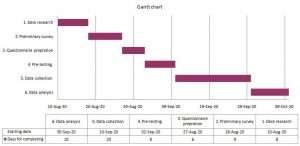
Variables and their measurement: Describe how the concepts, constructs and the variables were identified; this aspect is linked with the theoretical orientation. Provide the operational definition; it means how the variable is measured, mention the level of measurement also. A schematic table would suffice (for example, see Table 7).
Table 7. List of variables their method of measurement and operational definition
F. Statistical analysis: Mention all the statistics tools applied and software(s) used to analyse the research data (in thesis).
G. Ethical considerations: All the ethical aspects considered in the study need to be clearly planned and mentioned. Mention about respondent consent, how sensitive information (in synopsis) was elicited, if any. Report the approval of Research ethics committees, if applicable.
The difference between a researcher and a non-researcher is, whatever a researcher does she/he does it systematically, justifies logically, subjects it to verification, is always open to criticism, ready for self-correction and explicitly expresses what was done, how it was done, why it was done and what was found. A researcher starts with a research problem, raises questions, and transforms it into workable objectives. To find answers to the research questions, we need a sound research methodology. Research onion is one such framework that helps in designing a robust research methodology; simply put, it will help you to make a series of decisions that allows systematic research. We began with three assumptions, viz., ontological, epistemological and axiological, which constitute our research philosophy. Once we decide on the specific philosophy, an appropriate research approach can be adopted based on the research question and philosophy. The deductive approach is adopted for theory testing, inductive approach for theory building, and abductive approach for theory modification.
Further, these two crucial decisions will guide the next important aspect that is research design, which is made up of three important decisions: 1. Methodological choice – whether to follow a qualitative method, quantitative method or a mixed method; 2. Research strategy; and 3. Time horizon – cross-sectional or longitudinal research. Furthermore, the last decision is about very minute intricacies of research that is data collection, analysis and ethical statement.
Authors’ observation
It is often observed in academic discussions that various aspects of research are presented and (or) perceived to be competitive (quantitative versus qualitative, parametric versus non-parametric, probability sampling versus non-probability sampling, small sample size versus large sample size, experimental design versus non-experimental, cross-sectional versus longitudinal, and so on) rather than complimentary. Every aspect of research has got its own importance and relevance. A research scholar values every logical approach to research, and it is possible only after looking at it through all dimensions via the lenses of different questions (why, what, when, where, who, what).
Acknowledgement
I wish to acknowledge and thank the AESA, CRISP, ICAR-CTCRI, MANAGE, NAARM collaborative National Workshop on ‘Advances in Social and Behavioural Science Research’ held from 12 to 17 November 2018 at ICAR-CTCRI, Kerala. This event was an eye opener for me which oriented me towards social science research methodology, and indirectly helped me in my PhD research.
Babbie E. 2010. The practice of social research. 12th Edition. Belmont, USA: Wadsworth.
Bristow A, Robinson S K and Ratle O. 2017.Being an early career CMS academic in the context of insecurity and ‘Excellence’: The dialectics of resistance and compliance’. Organization Studies 38(9):1185–1207.
Bryman A and Bell E. 2015. Business research methods Oxford: Oxford University Press.
Burrell G and Morgan G. 2016. Sociological paradigms and organisational analysis. Abingdon: Routledge (originally published by Heinemann 1979).
Caruana E J, Marius Roman, Jules Hernández-Sánchez and Piergiorgio Soll. 2015. Longitudinal studies. Journal of Thoracic Disease 7(11):537–540. doi: 10.3978/j.issn.2072-1439.2015.10.63. Retrieved from https://www.ncbi.nlm.nih.gov/pmc/articles/PMC4669300/
Chen Y Y, Shek D T L and Bu F F. 2011. Applications of interpretive and constructionist research methods in adolescent research: Philosophy, principles and examples. International Journal of Adolescent Medicine and Health 23(2). doi:10.1515/ijamh.2011.022 https://pubmed.ncbi.nlm.nih.gov/21870675/
Chia-Pin Yu, Shu Tian Cole and Charles Chancellor.2018. Resident support for tourism development in rural midwestern (USA) communities: Perceived tourism impacts and community quality of life perspective. Sustainability, MDPI, Open Access Journal 10(3):1-17.
Crist J D, Parsons M L, Warner-Robbins C, Mullins M V and Espinosa Y M. 2009. Pragmatic action research with 2 vulnerable populations. Family & Community Health 32(4):320–329. doi:10.1097/fch.0b013e3181b91f
Crotty M. 1998. The foundations of social research: Meaning and perspective in the research process. London: Sage.
Collis J and Hussey R. 2013. Business research: A practical guide for undergraduate and postgraduate students. Macmillan International Higher Education.
Creswell J W. 2013. Qualitative inquiry & research design; choosing among five approaches. Third edition. Thousand Oaks, CA: Sage.
Ferguson K M, Kim M A and McCoy S. 2011. Enhancing empowerment and leadership among homeless youth in agency and community settings: A grounded theory approach. Child and Adolescent Social Work Journal 28(1):1-22. https://doi.org/10.1007/s10560-010-0217-6
Hastorf A H. 1997. Lewis Terman’s longitudinal study of the intellectually gifted: Early research, recent investigations and the future. Gifted and Talented International 12(1):3–7. doi:10.1080/15332276.1997.11672858
Saunders M, Lewis P and Thornhill A. 2007. Research methods for business students. (6th ed.) London: Pearson.
Saunders M, Lewis P and Thornhill A. 2019. Research methods for business students. Eighth edition. London: Pearson.
Setia M S. 2016. Methodology series module 3: Cross-sectional studies. Indian Journal of Dermatology 61:261-4. Retrieved from http://www.e-ijd.org/text.asp?2016/61/3/261/182410
Thomas Houghton. 2011.Does positivism really ‘work’ in the social sciences? Link: https://www.e-ir.info/2011/09/26/does-positivism-really %E2%80%98work%E2%80%99-in-the-social-sciences/

You may also like

Blog 230-Digital Extension Services in Punjab, Pakistan

Blog 229- How Participatory Approaches can Enhance Soil Health

Blog 228- Are agriculture podcasts a new way to deliver extension services?
Cancel reply.
Very interesting blog. Enjoyed reading it. I do have a small difference of with respect to one of the statements. Author says ‘you need not be apologetic in saying that sample was small or methods limit interpretation’. I am a firm believer of transparent communication and I feel that it is the role of a researcher to know the limits of the study and also communicate it to the readers, and there is nothing to be apologetic about it (Bsically I disagree with the term too). Infact I see many paper where they make very strong causal statements, when the methods are not really designed for it which I see as a more serious concern. This is my humble opinion, as academician I really enjoyed the blog. I appreciate the efforts of the author in elaborating on a very Important topic.
Thank you Aditya, thank you for your observations and. The very purpose of this blog was to make things systematic and clear. Yes the author strongly believe in reporting every aspect of the research including limitations provided they are indeed limiting the research design. Here the author is trying to state that when the research design demands or permits certain conditions those conditions should not be expressed as limitations, and it doesn’t imply any aspect should be hidden. I welcome your disagreements in the usage of words, we can disagree to agree. I strongly agree with you that even I enjoyed working on this blog. Thank you once again.
Well written.
Very comprehensively covering different paradigms in research methodology, with interesting analogy, Dr Mahesh could peel out research onion, explaining each layer starting from research philosophy to the data collection. Congratulations to Dr Mahesh. Further one important inner layer could be added to the onion, which would make it complete-the layer of research reporting/research communication. Unless we plan how we are going to communicate our research to the others, and communicate effectively through research paper, conference etc., research remains incomplete.
Very Good effort to write the blog to make research methodology easy to understand, Dear Mahesh , I enjoyed reading it

The research onion for beginners
Today I will explain the research onion in simple terms. This builds on from my last post, where I introduced you to the concept of research philosophy , giving the simple analogy of a tree which demonstrated how philosophy is inherently linked to research design.
What is the research onion?
Layers of the research onion, research philosophy, research approach, research strategy, time horizons, data collection and analysis.
The research onion was developed by Saunders et al in 2007 to describe the stages through which a researcher must pass when developing an effective methodology. Just as I previously explained, in order for your research to have maximum credibility, you must provide explanations and justifications for each level of your methodological decisions. The research onion is basically an extension of the research methods tree.
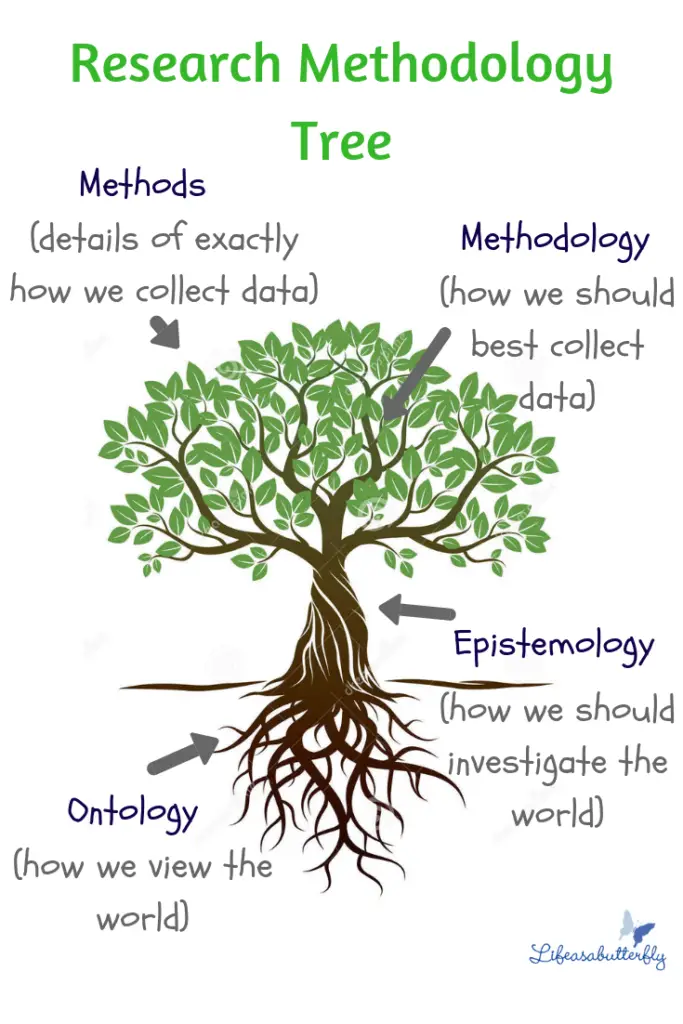
As you can guess, there are different layers to the research onion – the premise being that you start from the outside and peel each layer away until you reach the core. These layers are broken up into six main areas: research philosophy; research approach; research strategy; research choices; time horizons; and techniques and procedures. I will explain what each layer means below.
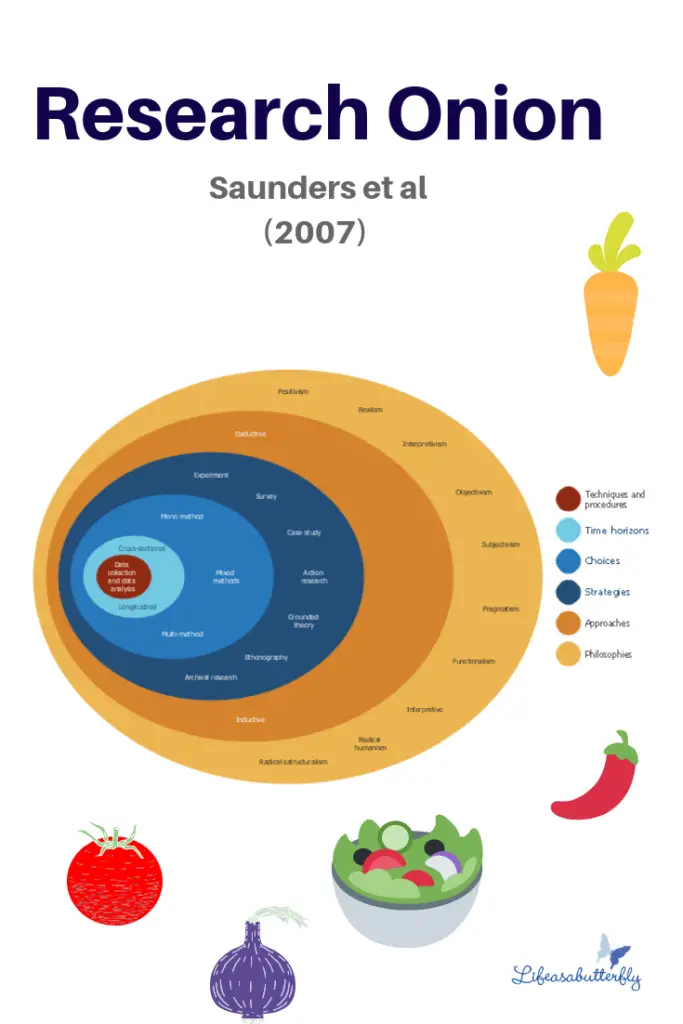
Research philosophy refers to the set of beliefs concerning the nature of the reality being investigated. It is generally examined in terms of ontology and epistemology. I have provided more detail on this in my post- ‘ Ontology and Epistemology: A Simple Explanation ’, but for now I will provide a brief description of each as follows:
- Epistemology: What Constitutes Valid Knowledge and How Can We Obtain It?
- Ontology: What Constitutes Reality and How Can We Understand Existence?
There are two main positions considered here, known as positivism and interpretivism. This underpins the qualitative versus quantitative debate, often referred to as “the scientist versus detective” debate. I explain exactly what all of this means in my post- ‘ Positivism and Interpretivism: A Simple Explanation ’.
This is referring to the approach that the researcher takes, which can largely be described as either inductive or deductive.
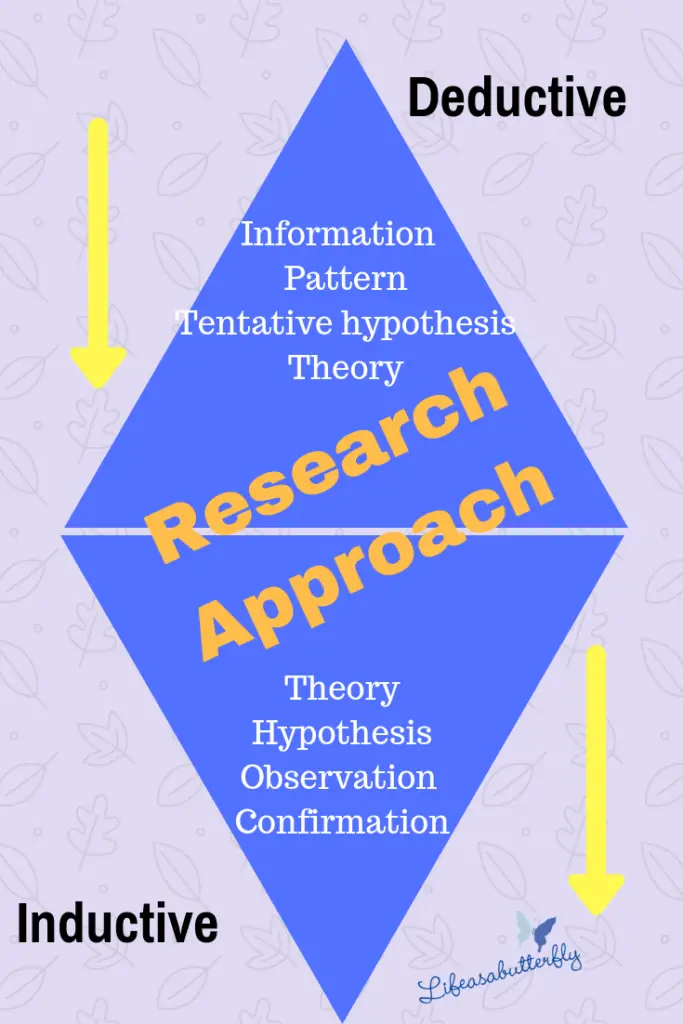
The deductive approach starts small and gets bigger. It starts with a specific hypothesis or hypotheses that have been developed based on information or patterns that have been observed by the researcher. It then seeks to test this hypothesis and develop a broader theory from it.
The inductive approach is the opposite. It starts with a broad theory and then focuses later on the smaller, more specific details. This is sometimes referred to as a move from the specific to the general.
Typically, a deductive approach is associated with quantitative research and an inductive approach is associated with qualitative research.
There are some great texts on this, which will give you a more detailed explanation. One of my favourites is ‘ Key Concepts in the Philosophy of Social Research’ by Malcolm Williams , which I used a lot when writing my PhD thesis.
The strategy layer of the research onion refers to how the researcher intends to carry out the work, i.e. what method of data collection will be used. You can read more about research method strategies in Cresswell’s book ‘ Research Design: Qualitative, Quantitative, and Mixed Methods Approaches ‘ .
The choices outlined in the research onion include the mono method, the mixed method, and the multi-method.
The mono-method involves using one research approach for the study. Next, the mixed-methods required the use of two or more methods of research, and usually refers to the use of both a qualitative and a quantitative methodology. In the multi-method, a wider selection of methods is used. You can also read more about the use of mixed methods research in Cresswell’s text , which is personally one of my favourites- it’s easy to understand and provides detailed explanations.
The Time Horizon refers to the time frame within which the project is intended for completion. According to the research onion, there are two types of time horizons: cross-sectional and longitudinal.
The cross-sectional time horizon is when there is a pre-set time established for the collection of data. A longitudinal time horizon refers to the collection of data repeatedly over an extended period, for example when a person reaches a different age or different seasons throughout the year.
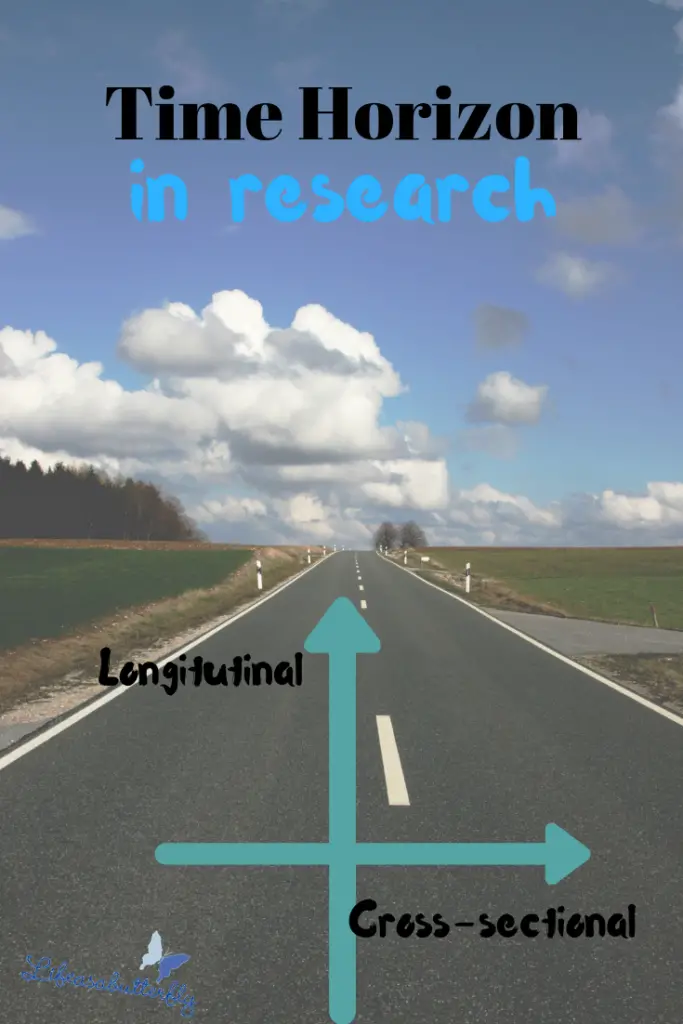
The final layer of the research onion is techniques and procedures. This is the section where you should make explicit exactly how and why you are undertaking the research.
This can be referring to primary data (data collected first-hand for the research project), or secondary data (data that was collected by somebody else and subsequently published).
You will need to make your research design clear, with valid justifications for each stage. This provides a framework that includes the considerations that led to the appropriate methodology being adopted, the way in which the respondents were selected, and how the data will be analysed.
You will also cover research samples in this inner layer of the research onion. A sample is a representative segment of a larger population . In this instance, it is referring to the people who participated in your study. You will need to explain who was selected and why, supported by sampling theory, which you will find in most research methods textbooks. The reader will also want to know about your sample size.
Lastly, it is worthwhile addressing the ethics of your research in this last section of the research onion. This demonstrates that you have been an ethical researcher and that you comply with any regulations set upon you by your university.
So, that sums up the research onion. And in actual fact it sums up your overall methodology chapter for your research project! I have a number of posts covering each of the areas mentioned in the research onion further, so read on should you require further guidance. I also recommend that you use some of the excellent research methods books available to you- I recommend Social Research Methods by Bryman and Research Methodology: A Step by Step Guide for Beginners by Kumar .
Lastly, I have also included a handy YouTube video below that explains the research onion very clearly (I’ll get round to making my own one day).
If you wish to cite any of the content in the post please reference ‘Stainton, Hayley. (2018) Lifeasabutterfly.’

IMAGES
COMMENTS
Learn about Saunders' (2007) ever-popular "Research Onion". We explain the onion in simple, straightforward language (with many examples).
Feb 17, 2023 · This paper explains a systematic approach to designing a research methodology, using the ‘research onion’ model of Saunders et al., 2007, and examines both its significance and relevance in...
The research onion suggests that strategies can include action research, experimental research, interviews, surveys, case study research or a systematic literature review. The strategy is chosen based on the data required for the research and the purpose of the study.
The research onion is a metaphorical model that visualizes the layers of a research study, emphasizing the progression from broad philosophical assumptions to specific research methods and techniques.
Aug 27, 2020 · Developing a good research design is important while undertaking quality research, and the different stage in research designing can be illustrate by using the research onion framework (Tengli...
Sep 14, 2023 · Research onion is a framework for developing different types of research methodology, depending upon the objective of the study. Research onion was developed by Saunders et al (2007) in their book “Research Method for Business Students”.
Jan 17, 2023 · One useful tool to help you structure your methodology chapter is the Saunders Research Onion. Developed by Professor Mark Saunders, the Saunders Research Onion is a unique and versatile research framework that can help guide you through the process of conducting and reporting research.
The Research Onion model, developed by Saunders et al., is a framework that outlines the stages and layers involved in the development of a research methodology. Here’s a detailed table with sections, subsections, and sub-subsections of the Research Onion, along with expanded explanatory notes:
Aug 27, 2020 · Developing a good research design is important while undertaking quality social science research, and in this blog Dr Mahesh BT illustrates the different stages in designing a research methodology using the Research Onion framework.
Feb 14, 2023 · What is the research onion? The research onion was developed by Saunders et al in 2007 to describe the stages through which a researcher must pass when developing an effective methodology.